![]()
Please refer to the Settings Guide for details.
 3.8.1 Creating a New Project
3.8.1 Creating a New Project
 5.4.1 System Settings [Display] Settings Guide
5.4.1 System Settings [Display] Settings Guide
This section explains the workflow from starting GP-Pro EX to creating, saving, and exiting projects.
![]()
Please refer to the Settings Guide for details.![]() 3.8.1 Creating a New Project
3.8.1 Creating a New Project
![]() 5.4.1 System Settings [Display] Settings Guide
5.4.1 System Settings [Display] Settings Guide
Double-click the shortcut ![]() on the desktop, or from the [Start] menu, point to [Programs (P)], then [Pro-face], and select [GP-Pro EX *.**]. (The asterisks ** define the version number.)
on the desktop, or from the [Start] menu, point to [Programs (P)], then [Pro-face], and select [GP-Pro EX *.**]. (The asterisks ** define the version number.)
When you launch GP-Pro EX, the following dialog box appears.
From the next time you start GP-Pro EX, you can check for software update information every time you launch GP-Pro EX. Select the [Check for Update when the program starts] check box, then click [OK].
If you want to check for updates only when necessary, clear the check box and click OK.
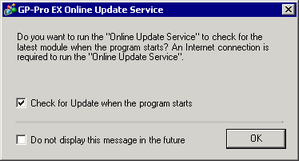
![]()
For the procedure on checking for updates only when required, see the following.![]() 3.10 How to Update GP-Pro EX
3.10 How to Update GP-Pro EX
The [Welcome to GP-Pro EX] dialog box appears. Select [New] and click [OK].
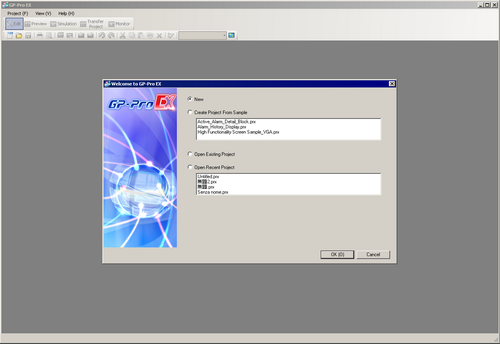
![]()
To create a new project, from the [Project (F)] menu, select [New (N)]. You can also click the ![]() , to create a new project. The [Welcome to GP-Pro EX] dialog box appears.
, to create a new project. The [Welcome to GP-Pro EX] dialog box appears.
You can create a project file based on sample projects stored in the [Sample] folder. In the welcome dialog box, select [Create Project from Sample]. The project will be read-only. Save the file using the [Project (F)] menu's [Save As (A)] command.
In the next screen, from [Series] select [GP3000 Series], and then select the screen size series, [Model] and [Orientation]. Then click [Next].![]() 1.4 Supported Model List
1.4 Supported Model List
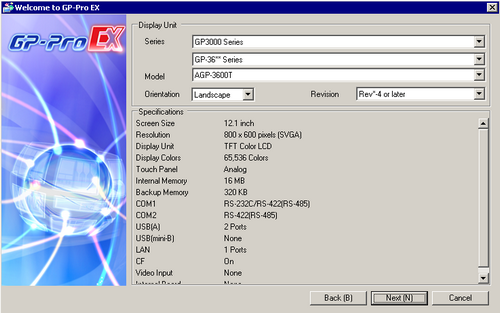
![]()
[Specifications] shows the specifications of the selected display model.
If you select [GP2000 Series], GP-Pro EX exits and GP-PRO/PBIII for Windows starts. GP-PRO/PBIII does not start if not installed.
When you select the [IPC Series (PC/AT)], you do not need to set [Orientation]. Specify the data display size in [Screen Size].
The following screen is displayed. Select [Manufacturer], [Series], and [Port], and then click [Communication Settings].
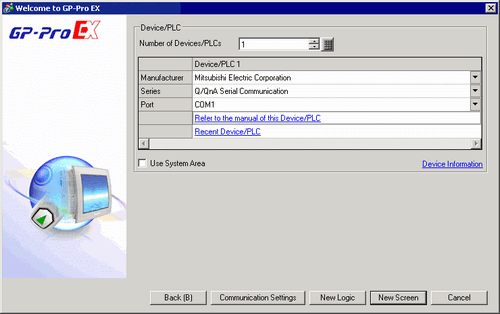
![]()
To create a screen without configuring communication settings for the device/PLC series, click [New Screen]. The screen editor will display [Base 1].
To create a logic program, click [New Logic] to display the logic editor [Main].![]() 30. Logic Programming
30. Logic Programming
If you select the [Use System Area] check box, you can set up the display unit's internal system data area on the device/PLC.![]() 5.4.6 System Settings [Display Unit] - [System Area] Settings Guide
5.4.6 System Settings [Display Unit] - [System Area] Settings Guide
When selecting the [LT3000 Series], click [Next] to show the following screen and then select the I/O driver to be used.
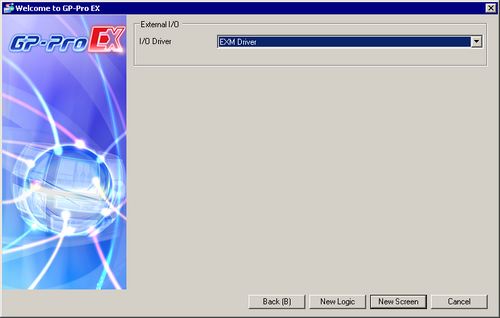
The [New Project File] dialog box closes and the [System] tab is displayed in the main window. Click [Device/PLC1].
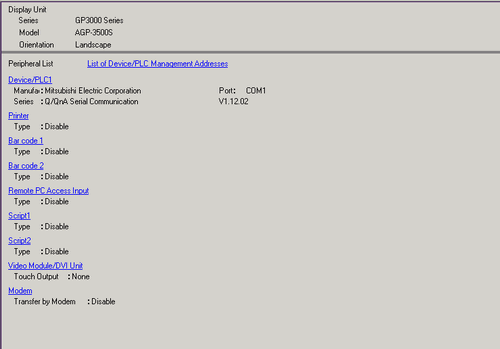
When [Device/PLC] is displayed, specify the communication settings.
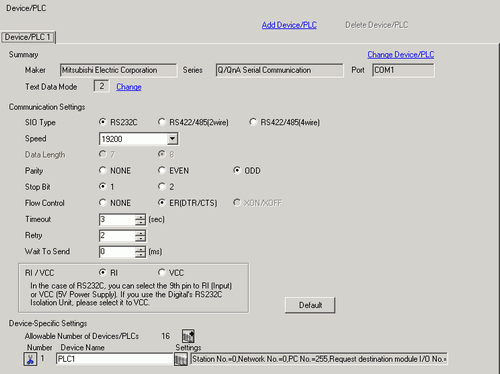
![]()
The [Communication Settings] details differ depending on the device/PLC series. See the "GP-Pro EX PLC/Device Connection Manual" for your device/PLC.
It is recommended to keep the default settings for [Timeout], [Retry], and [Wait to Send].
Open the Screen List window and double-click the base screen.
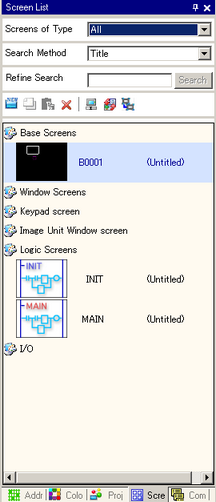
![]()
If the [Screen List] is not on the workspace, from the [View (V)] menu, point to [Work Space (W)] and select [Screen List (G)].
To create a logic program, double-click the logic screen currently displayed. If you select a model that does not support the logic features, you can create the logic program but the program will not run on the display.![]() 30. Logic Programming
30. Logic Programming
The [Base Screen] displays, as shown.
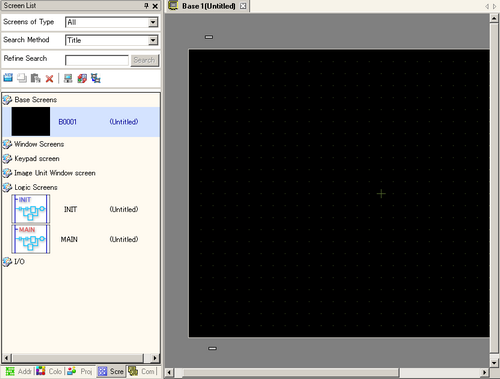
Create a screen.
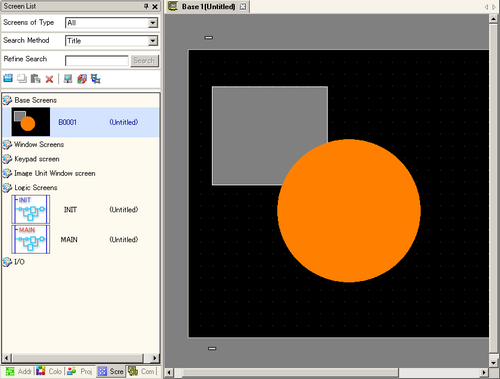
Add a new screen.
From the [Screen (S)] menu, select [New Screen (N)] or click ![]() . The [New Screen] dialog box appears. Select the [Screens of Type], specify the screen number and [Title] then click [New].
. The [New Screen] dialog box appears. Select the [Screens of Type], specify the screen number and [Title] then click [New].
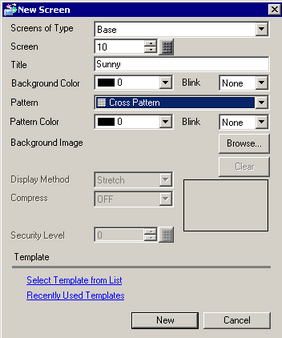
[Base 2] appears.
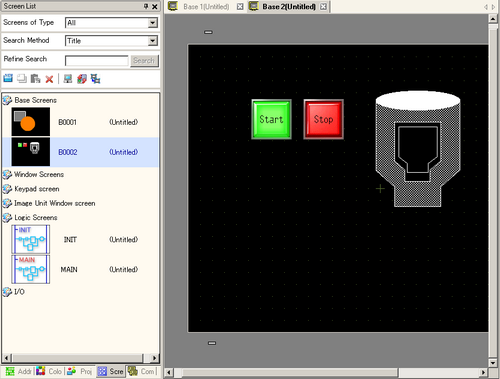
![]()
You can check the display state on the display unit, even during drawing mode, by clicking the [Preview] icon. (It is displayed in the colors of the model.)
From the [View (V)] menu, point to [Workspace (W)] and select [Properties (P)] to check simple operations such as switching between show and hide Window parts, individually changing the state of Switch Lamps, and displaying temporary values in the data display unit.
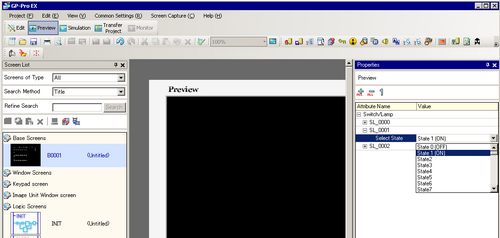
You can save the displayed preview screen in a JPEG file format by clicking [Export to File (F)] from the [Screen Capture (C)] menu.
After confirming the display, click [Edit] on the State bar to return to the screen editor.
To close the screen that is open, click the right side ![]() of the screen tab, or right-click the tab and use the menu that is displayed.
of the screen tab, or right-click the tab and use the menu that is displayed.
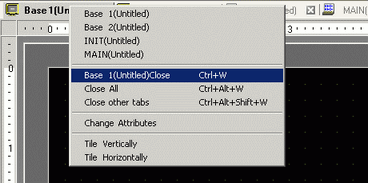
The tab display is saved when you close the project. The next time you open the project, the tab display will be the same as when you exited.
From the [Project (F)] menu, select [Save As (A)].
The [Save As] dialog box appears. Define the storage location and file name and click [Save].
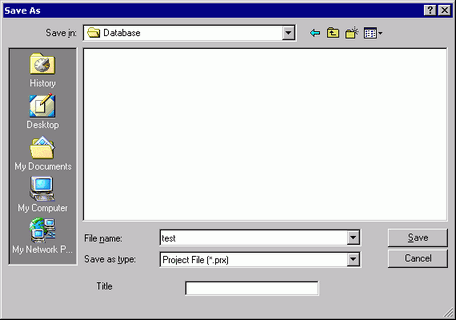
![]()
Your file name can contain up to 255 characters, including the file extension.
Error checks are automatically performed when projects are saved. If there are problems with the Project Files, the content will be displayed in the [Error Check] Window. By double-clicking the displayed rows, the screen with problems is displayed, so please , modify the relevant areas.

To verify operation, in the status bar click [Simulation]. ![]() 33.1 Settings Menu
33.1 Settings Menu
Finishing
From the [Project (F)] menu, select [Exit (X)] or click the icon ![]() on the top right section of the screen.
on the top right section of the screen.